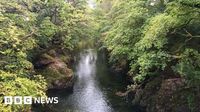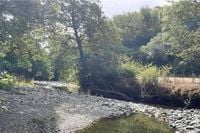North Wales has officially joined the growing list of regions in the United Kingdom grappling with drought, as Natural Resources Wales (NRW) declared the area in drought status on August 29, 2025. This move comes hot on the heels of a similar declaration for south east Wales earlier in the month, despite some recent rainfall that had residents hoping for a reprieve. The situation underscores the persistent grip of an unusually dry and hot spring and summer, which have left rivers, groundwater, land, and wildlife under mounting stress.
The announcement followed a meeting of the Welsh Government’s Drought Liaison Group, which reviewed the latest hydrological data and considered the broader consequences of low river flows and depleted groundwater reserves. According to Nation.Cymru, concerns were raised during the meeting about the escalating environmental impacts, including reports from NRW teams and the public of streams drying up and fish found in distress, particularly in north Wales.
One of the most visible signs of the crisis unfolded over the August bank holiday weekend, when a significant wildfire swept through the Newborough National Nature Reserve, forcing its temporary closure. Similar wildfires also struck the Welsh Government Woodland Estate in the south Wales valleys, further illustrating the tinderbox conditions prevailing across the country.
The drought’s effects have been especially acute for Wales’s rivers and aquatic life. In south east Wales, consistently low river flows and high temperatures have taken a toll on salmon populations, with adult salmon mortalities reported. Advice has been circulated to the angling community regarding safe practices, as noted by North Wales Live. Ben Wilson, Principal Advisor at NRW, explained, “The rainfall this week will provide some welcome respite for our environment, land and wildlife, but it will take many months, and more consistent rainfall for our environment to fully recover.”
Despite the challenging conditions, water companies have assured the public that drinking water supplies remain safe. Dŵr Cymru Welsh Water confirmed that there are no plans for temporary use (hosepipe) bans, but both they and NRW are urging people and businesses to use water wisely. As Wilson emphasized, “While essential water supplies remain safe, we’re urging people to think carefully about their own water usage in the home and at work, to protect supplies for the environment as well as public water supplies.”
The drought’s reach is extensive, affecting a swath of north Wales that includes Dee (Wales), Upper Severn, North Gwynedd (Conwy, Anglesey, Arfon, Dwyfor), South Gwynedd (Meirionydd), and Clywd. According to Wrexham.com, south west Wales, which received some rainfall during the week of August 25–29, remains at prolonged dry weather status but is under close monitoring.
Statistics paint a stark picture of the scale and severity of the event. The six-month period from February to July 2025 was the driest since the famous drought of 1976, placing extreme pressure on rivers, groundwater, agriculture, and wildlife. During this period, Wales received just 555mm of rainfall—almost as dry as in 2022, when the entire country was declared in drought by September. By August 26, 2025, Wales had received only 22.43% of its monthly average rainfall, leaving most river flows and groundwater levels across the country low or exceptionally low.
Wilson elaborated on the historical context, saying, “The six-month period between February and July was the driest since the drought of 1976, and has placed extreme pressure on our rivers, groundwaters, agriculture and wildlife. In some areas, this has caused river flows and groundwater levels to drop below historic lows.” He added that as Wales heads into autumn, NRW will continue to monitor weather forecasts, river flows, and groundwater levels, while responding to reports of environmental incidents caused by the drought.
But the environmental impacts are only part of the story. The drought has also affected private water supplies in some areas, disrupted land management, hindered tree planting efforts, and complicated navigation and recreational activities. Farmers have been particularly hard-hit, with many now seeking alternative livestock watering sources and supplementary feeding due to reduced grass growth and the loss of recently planted trees. These knock-on effects ripple through rural communities, compounding the challenges posed by the prolonged dry spell.
North Wales experienced a record-breaking August bank holiday, with the Met Office reporting temperatures reaching 29.1°C in Hawarden, Flintshire—a figure that highlights the intensity of the recent heat. The period between February and July 2025 was not only the driest since 1976, but also ranked as the 16th driest in 190 years, according to NRW.
Climate change looms large over these developments. Wilson warned, “As climate change accelerates, summers in the UK are expected to become drier, and extreme weather events will become more frequent and intense.” This warning is echoed by water companies and environmental agencies, who stress that the current drought could become a more common occurrence in the years ahead unless significant changes are made to how water resources are managed and conserved.
Despite the gravity of the situation, NRW and its partners remain focused on a coordinated response. The agency is working closely with the Welsh Government, water companies, and other stakeholders to provide a comprehensive picture of conditions across the country. NRW has also encouraged the public to report signs of environmental incidents—such as dry river beds, fish in distress, or pollution—via its online incident form or 24-hour hotline.
It’s worth noting that water companies have their own definitions and triggers for drought, which may not always align with NRW’s declarations. This sometimes leads to confusion among the public regarding the severity of the situation and the appropriate response. However, the consensus among experts is clear: the combination of record-low rainfall, soaring temperatures, and mounting environmental stress has placed Wales in a precarious position.
Looking ahead, the path to recovery will be slow and dependent on consistent rainfall over the coming months. In the meantime, officials urge everyone—residents, businesses, and visitors alike—to do their part in conserving water and protecting the environment. As Wilson put it, “If people are out and about enjoying the last of the summer holidays and see signs of environmental incidents – such as dry river beds, fish in distress or pollution – they should report it via our online incident form or call our 24-hour hotline.”
The drought declaration for north Wales serves as a stark reminder of the region’s vulnerability to climate extremes and the urgent need for both immediate action and long-term adaptation. As Wales braces for what could be a prolonged recovery, the hope is that collective vigilance and careful stewardship of resources will help safeguard the environment—and the communities that depend on it—for the future.





